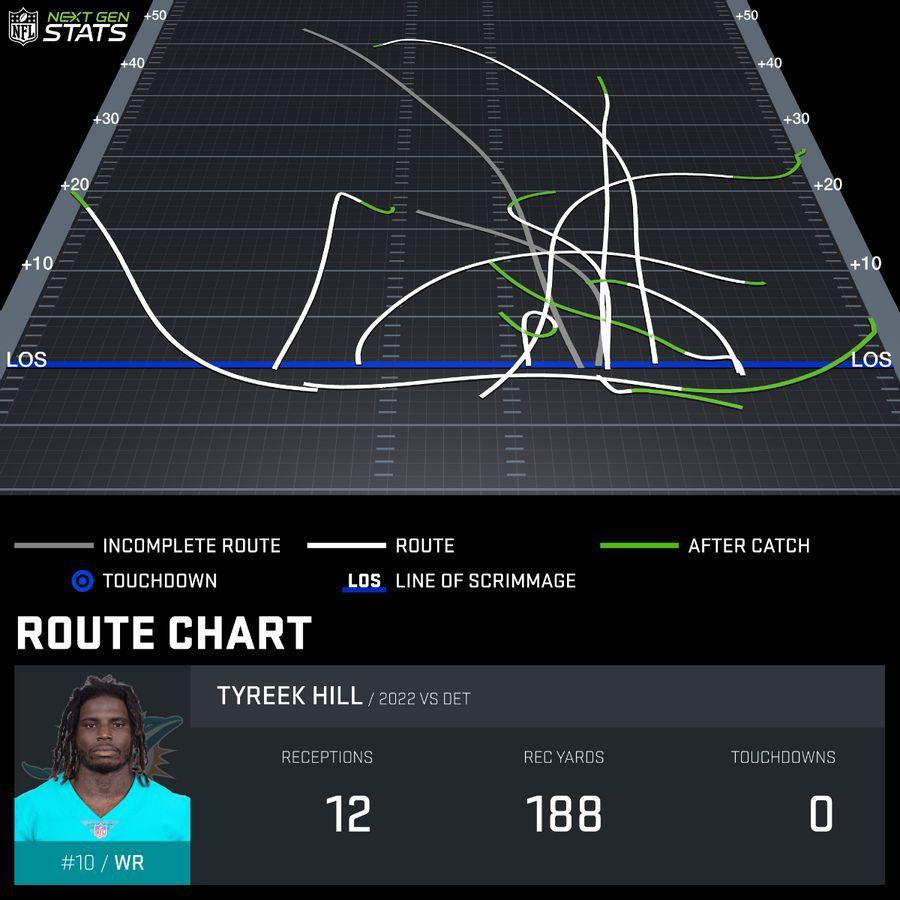The NFL always will be a quarterback-driven league. That’s true even in 2022, when passing numbers are down and a handful of stars are having their worst seasons in recent memory. The MVP discussion is still being dominated by quarterbacks, like Patrick Mahomes and Josh Allen—hardly a surprise for two players widely viewed as the best at the position. But even the second tier of candidates features passers, in this case guys who came into the season needing to prove they were viable long-term options for their respective teams. Third-year quarterbacks Tua Tagovailoa and Jalen Hurts have staked that claim emphatically as we head into the second half of the season. Geno Smith is nearing that point too—and though he may not garner serious consideration for MVP, he will earn himself a nice payday if he can stay on this pace.
Maybe this rise of the middle class of quarterbacks means there’s been a seismic shift in the NFL’s landscape, and that Tagovailoa, Hurts, and Smith will continue to play like top-10 QBs for the foreseeable future. I’m certainly willing to entertain that thought, as all three have played legitimately good football this season. Still, it’s hard to ignore the fact that they are all surrounded by stellar supporting casts and have enjoyed a margin for error that most quarterbacks in this league do not have.
That reality has been highlighted further by the struggles of some of the league’s more established stars, including the future Hall of Famers in Green Bay and Tampa Bay. Aaron Rodgers is trying to bring along a young receiving corps that’s short on talent. Tom Brady has been working with a rotating cast of receivers due to injuries, and an offensive line that can’t hold up for more than two seconds. Matt Ryan was benched because he couldn’t exist behind the Colts’ porous line. Matthew Stafford has fallen in the league’s passing charts as he deals with bad protection and a painfully thin receiving corps outside of Cooper Kupp. It’s not just the aging quarterbacks, either: Justin Herbert and Kyler Murray both got off to nightmarish starts as they tried to navigate the early part of the season without their top receiving options. If we dropped any of those players into the offenses in Miami, Philadelphia, or Seattle, they’d probably be having vastly different years.
That doesn’t mean Tua, Geno, and Jalen don’t deserve credit for leading their teams to stellar results. The Dolphins offense hardly looked the same with Teddy Bridgewater and Skylar Thompson filling in for Tagovailoa while he was recovering from a concussion. Russell Wilson wasn’t producing these results last year in Seattle with a comparable supporting cast. And the Eagles offense is designed around Hurts’s run threat—a QB change would necessitate a foundational shift in scheme. These guys are playing their roles at a high level; their teams just aren’t asking them to carry the load in the ways we’ve seen in the past.
So far, this season is showing that while the NFL always will be a quarterback-driven league, the degree to which that is true can vary. Whether it’s a result of defensive evolution or a decline in quality of play, this seems to be a year in which supporting cast matters more than usual—and the teams expected to occupy the top of the standings before the season kicked off, thanks in large part to their star quarterbacks, could very well find themselves watching the playoffs from home.
The rise of teams led by middle-of-the-pack QBs and the declining production of passing games across the league feels connected. In recent years, NFL defenses have started selling out to stop deep passes, opting to give up a numbers advantage in the run box in order to drop an extra safety deep into coverage. With more bodies populating the deep and intermediate parts of the field, offenses are finding it harder to produce explosive gains in the passing game. The league-wide average depth of target is the lowest it’s been since the stat has been tracked (2006), and the value of the average completion, by EPA, is the lowest since the turn of the century. Completions aren’t as valuable as they’ve been in the past, and the more difficult throws are getting harder to pull off even for the best passers in the league.
Meanwhile, skill-position players have never been better at generating production after the catch. The average reception has produced 0.68 EPA after the catch, the highest we’ve seen over the past 17 years, as far as the data goes back. And while explosive pass rates are down, explosive run rates are up. The highest they’ve been since 2000, in fact. We’re talking about an awfully small sample size, with the season not even halfway over, but the numbers suggest that the playmaking burden this year has shifted from the quarterbacks to the guys they give the ball to.
That certainly feels like the case when you watch the Dolphins. Sunday’s 31-27 win over the Lions was more proof that Miami’s trade for Tyreek Hill was one of the best moves of the offseason. The former Chiefs receiver racked up 188 yards receiving, and he probably would have gone for over 200 if not for some questionable ball placement from his quarterback on a few key throws.
It’s not that Hill was taking short passes and turning them into big gains. He wasn’t:

But the threat of his speed, coupled with that of Jaylen Waddle and coach Mike McDaniel’s intricately designed scheme, has created so much space for the Dolphins passing game that it’s almost impossible for the quarterback to fail.
And Tua is hardly failing. He is capitalizing on that space by making the necessary throws. And his quick trigger on RPOs, which the Dolphins run third-most in the league, has helped to make up for an inconsistent rushing attack. The third-year pro certainly looks better than he has in years past—but only the most dedicated member of Tuanon would deny that things would be a lot different with another combination of receivers.
We don’t have to speculate in the case of Hurts and the Eagles. This offense is largely the same one we saw in 2021, both from a personnel and a coaching perspective, except for one key difference: A.J. Brown. The star receiver, for whom the Eagles traded on the first day of the draft, spent Sunday repeatedly dunking on the entire Steelers secondary and helping the Eagles remain the NFL’s lone undefeated team.
After the game, Philly tackle Lane Johnson was asked to explain how his team put the game away. His explanation wasn’t overly complex:
Just throwing that motherfucker to no. 11 has served the Eagles well all year. Brown’s made plays in the deep passing game, and he’s turned short passes into explosive gains. The same can be said for DeVonta Smith. And the running game has been powered by a dominant, albeit banged-up, offensive line. Hurts, meanwhile, has made all the throws asked of him, and he’s created with his legs when the receivers couldn’t get open. It’s hard to say which facet of the offense has been most important, but I’m not sure it’s even worth divvying up the credit. Philadelphia has been so good because there isn’t a focal point for defenses to home in on.
That’s true in Seattle, too, even if the Seahawks offense is thriving in more traditional ways. In Miami and Philadelphia, we’ve seen unorthodox approaches to play-calling, especially on early downs when those teams use college-style RPOs as the foundation for the offense. The Geno-led Seahawks, on the other hand, look more like a classic NFL offense—but the secret to their success is the ability to do a little bit of everything. Smith’s star turn has allowed offensive coordinator Shane Waldron to open up the playbook, sure, but we can’t overlook the importance of Seattle’s offensive line, its run game, and its two star receivers, DK Metcalf and Tyler Lockett. Smith has been more than a distributor in this system, but he’s also been provided with consistently clean pockets and open options downfield. That’s been a rare luxury for quarterbacks across the league.
And it’s not just receivers who are helping their offenses reach new heights. We’ve seen other teams lean heavily on running backs to move the football. The 49ers made the whole plane out of Christian McCaffrey in a comfortable 31-14 win over their rival Rams—one of the teams that have been unable to overcome clear personnel issues even with a star at quarterback. San Francisco’s midseason pickup started the scoring for his new team with an impressive downfield pass to a wide open Brandon Aiyuk. He later rushed for a touchdown and caught a touchdown pass, becoming the first player since LaDainian Tomlinson to accomplish the triple crown in a single game. And around those big plays, McCaffrey served as an outlet for Jimmy Garoppolo when things broke down—a significant development for an offense that needed some form of evolution after Trey Lance went down with an injury early this season. Easing Garoppolo’s burden and ensuring he doesn’t have to force passes downfield on third down could help to eliminate the disaster plays that have held this team back in the past.
The only running back with a heavier workload than McCaffrey on Sunday was Derrick Henry—which isn’t exactly a new development for the Titans, but with rookie Malik Willis filling in for an injured Ryan Tannehill, Tennessee took its RB-centric offense to the extreme. Willis attempted only 10 passes in a 17-10 win over the Texans, which produced 55 yards, while Henry carried the ball 32 times for 219 yards and a pair of touchdowns. His backup, Dontrell Hilliard, added another 83 yards on eight attempts. It looked like a service academy game, and Houston’s poor defense couldn’t stop this tandem even when it knew they were coming. It’s hard to get overly excited about a close win over a one-win Texans team, but Sunday’s game was proof that Henry is still capable of carrying an offense to victory.
If you scan the league’s current standings, you’ll find that the teams at the top of their divisions aren’t those with quarterback situations other teams would envy—at least, they wouldn’t have envied them before the season started. Nobody was clamoring for Jalen, Tua, Geno, Jimmy G, or even Ryan Tannehill and Kirk Cousins. The league appeared to be split in two between the haves and have-nots: those with established franchise quarterbacks, and those without. Expectations were high for the former group, while we questioned the ceiling of those in the latter. Now, eight weeks in, we can still divide the league’s offenses into haves and have-nots—but different position groups are deciding that placement.
